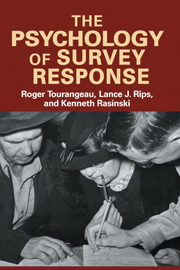Book contents
- Frontmatter
- Contents
- Preface
- 1 An Introduction and a Point of View
- 2 Respondents' Understanding of Survey Questions
- 3 The Role of Memory in Survey Responding
- 4 Answering Questions about Dates and Durations
- 5 Factual Judgments and Numerical Estimates
- 6 Attitude Questions
- 7 Attitude Judgments and Context Effects
- 8 Selecting a Response: Mapping Judgments to Survey Answers
- 9 Editing of Responses: Reporting about Sensitive Topics
- 10 Mode of Data Collection
- 11 Impact of Cognitive Models on Survey Measurement
- References
- Author Index
- Subject Index
10 - Mode of Data Collection
Published online by Cambridge University Press: 05 June 2012
- Frontmatter
- Contents
- Preface
- 1 An Introduction and a Point of View
- 2 Respondents' Understanding of Survey Questions
- 3 The Role of Memory in Survey Responding
- 4 Answering Questions about Dates and Durations
- 5 Factual Judgments and Numerical Estimates
- 6 Attitude Questions
- 7 Attitude Judgments and Context Effects
- 8 Selecting a Response: Mapping Judgments to Survey Answers
- 9 Editing of Responses: Reporting about Sensitive Topics
- 10 Mode of Data Collection
- 11 Impact of Cognitive Models on Survey Measurement
- References
- Author Index
- Subject Index
Summary
Over the last 25 years, the application of computer technology to the collection of survey data has revolutionized the survey industry. From its modest beginnings in 1971, when Chilton Research Services conducted the first computer-assisted telephone interviewing (CATI) survey for AT&T, CATI has become the most commonly used method for collecting data by telephone in the United States and Europe. In a CATI survey, the questionnaire takes the form of a computer program that displays the items to the interviewer on the computer screen; the interviewer then reads the questions to the respondent and enters the answers by pressing the appropriate keys. And, just as CATI has become the standard method for collecting data in telephone surveys, computer-assisted personal interviewing (CAPI) has become the standard method for face-to-face interviews. In the United States, one major federal survey after another – among them the National Medical Expenditure Survey, the National Longitudinal Survey of Youth, the Current Population Survey, the Medicare Current Beneficiary Survey, the National Survey of Family Growth, and the Survey of Consumer Finances – has converted from paper-and-pencil interviews to CAPI as its primary mode of data collection. CAPI uses essentially the same technology as CATI, except that the programs are loaded onto portable laptop computers that can be used in face-to-face interviews. Couper and Nicholls (1998) provide an excellent summary of the history of these developments.
- Type
- Chapter
- Information
- The Psychology of Survey Response , pp. 289 - 312Publisher: Cambridge University PressPrint publication year: 2000
- 2
- Cited by



